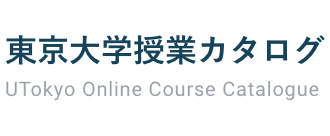過去(2023年度)の授業の情報です
学内のオンライン授業の情報漏洩防止のため,URLやアカウント、教室の記載は削除しております。
最終更新日:2025年4月21日
授業計画や教室は変更となる可能性があるため、必ずUTASで最新の情報を確認して下さい。
UTASにアクセスできない方は、担当教員または部局教務へお問い合わせ下さい。
最終更新日:2025年4月21日
授業計画や教室は変更となる可能性があるため、必ずUTASで最新の情報を確認して下さい。
UTASにアクセスできない方は、担当教員または部局教務へお問い合わせ下さい。
有機化学特論II
本講義では,前半ではラジカルを中心とした反応活性種(カチオンとラジカルアニオン,フリーラジカルとラジカル連鎖)の化学ついて学ぶ.歴史的・古典的な原著論文を読むことを基点とする.その後半 では,生体触媒化学・タンパク質化学・ペプチド化学・核酸化学について教科書から選び出した内容について講義と演習を通して理解を深める.有機化学I-IIIで履修した内容を前提とする.講義スケジュールは以下の通りである.
前半
1.Gombergのラジカル
2.「ラジカル」を阻んだもの:Ingold/Robinsonの功績
3.「ラジカル」苦労譚:KoelshとKharaschの例
4.「ラジカルの超共役」:現代化学での議論
5.「captodative effect」は存在するのか?
後半
1.酵素を模倣した分子認識の概要
2.生体分子を模倣したホストゲスト化学(超分子化学)とその合成化学への応用
3.抗体触媒
4. 有機分子触媒・ペプチド触媒・核酸触媒
In this class, you will learn reactive chemical species around "radicals" by reading classic/historical papers. Afterwards, in the S2 term, you will learn selected topics related to bioorganic chemistry (specially, biocatalysis, protein chemistry, peptide chemistry, and nucleic acid chemistry). You are supposed to master the contents of the classes of Organic Chemistry I–III. More specifically, the class will cover the following content:
In the S1 term,
(1) The origin from Gomberg
(2) What bothered the "radical" concept
(3) Difficult tasks to report "radical".
(4) Hyperconjugation in radicals?
(5) Captodative effects?
In the S2 term,
(1) Enzyme-mimetic molecular recognition
(2) Host-guest chemistry mimicking biomolecules and their application for synthetic chemistry
(3) Overview of catalytic antibody
(4) Organocatalysts, peptizymes, and ribozymes
前半
1.Gombergのラジカル
2.「ラジカル」を阻んだもの:Ingold/Robinsonの功績
3.「ラジカル」苦労譚:KoelshとKharaschの例
4.「ラジカルの超共役」:現代化学での議論
5.「captodative effect」は存在するのか?
後半
1.酵素を模倣した分子認識の概要
2.生体分子を模倣したホストゲスト化学(超分子化学)とその合成化学への応用
3.抗体触媒
4. 有機分子触媒・ペプチド触媒・核酸触媒
In this class, you will learn reactive chemical species around "radicals" by reading classic/historical papers. Afterwards, in the S2 term, you will learn selected topics related to bioorganic chemistry (specially, biocatalysis, protein chemistry, peptide chemistry, and nucleic acid chemistry). You are supposed to master the contents of the classes of Organic Chemistry I–III. More specifically, the class will cover the following content:
In the S1 term,
(1) The origin from Gomberg
(2) What bothered the "radical" concept
(3) Difficult tasks to report "radical".
(4) Hyperconjugation in radicals?
(5) Captodative effects?
In the S2 term,
(1) Enzyme-mimetic molecular recognition
(2) Host-guest chemistry mimicking biomolecules and their application for synthetic chemistry
(3) Overview of catalytic antibody
(4) Organocatalysts, peptizymes, and ribozymes
時間割/共通科目コード
コース名
教員
学期
時限
0530066
FSC-CH4207L3
有機化学特論II
菅 裕明
火曜1限
講義使用言語
英語
単位
2
実務経験のある教員による授業科目
NO
他学部履修
可
開講所属
理学部
授業計画
授業の目標、概要を参照のこと
Please check UTAS for URL addresses.
授業の方法
講義および演習
lecture and exercise
成績評価方法
出席およびレポートを総合して評価する.
Attendance, report and final exam
教科書
「ジョーンズ有機化学(上,下)」東京化学同人,「有機反応機構の書き方」丸善,および授業時間中に配布する印刷物をもとに講義を進める.
Handouts will be provided in the class. The following textbooks will also be used.: "The Art of Writing Reasonable Organic Reaction Mechanisms" by Robert B. Grossman; "Molecular Orbitals and Organic Chemical Reactions" by Ian Fleming.
参考書
講義内で指定する
履修上の注意
前半の磯部研担当分は対面にて実施、後半の菅研担当分はオンラインで実施する。
The first 6 classes will be provided by Prof. Isobe in person, and the following 6 classes will be provided by Suga laboratory staffs via zoom.
講義内容に応じて適宜予習・復習に励むこと。





 学部後期課程
学部後期課程

 マイリストに追加
マイリストに追加
 マイリストから削除
マイリストから削除


